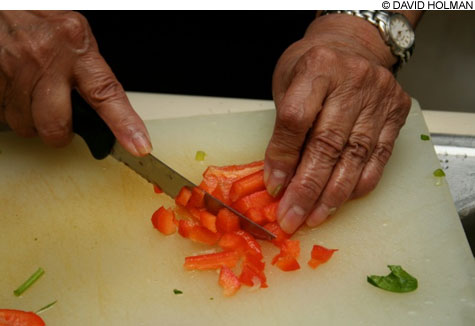
HANDLE WITH CARE Veggies are just the beginning.
|
Jenny Sanchez learned many of her magical dishes, including chancho frito and gallo pinto (previously featured here), from a family helper when she was a young girl. Her mother made sure all seven children watched and listened in the kitchen because in Nicaragua, Jenny explains, “You have to know how to cook,” usually by the time you’re 15. When I asked a group of 12-year-old Kenyan-Americans in Lewiston if any of them cooked, hands shot up: “I cook!” “I do!” “Me too!” When I ask people born here when Americans learn to cook, they say: “What’s your definition of cooking?”
Answering the question with a question shows, in my view, some discomfort in the concept of hundreds of millions of us never learning how to cook at all and relying almost completely on the business world to feed and nurture us. No one can say for sure that not cooking causes cancer, obesity, divorce, or depression, but I think it’s pretty hard to argue that not cooking is actually good for us. So let’s define, for those wondering Americans, cooking as making a delicious meal out of raw ingredients. And let’s start right now.
The dish Jenny is teaching us is tortas de espinaca, potato-spinach pancakes served with rice and topped with cheese, fresh tomatoes, and hot sauce. She learned this particular dish when she was in her 20s and studying in a Nicaraguan nursing school. A class called economia dieta taught her how to cook healthy food for patients within the hospital’s budget. Nurses? Cooking? Ah yes, food is the foundation of our health, in body, mind, and spirit. Isn’t it?
The list of ingredients is humble: fresh spinach, red pepper, green onion, garlic, eggs, grated potato, salt, hot sauce, and cheese. The magic is in Jenny’s method: basically coating a whole bowlful of cut veggies with raw eggs and lightly frying scoops like pancakes. As she’s chopping spinach she holds up the stems and instructs me to use them: “This is vayta min.” She folds the eggs gently into the vegetables and makes me write down “no whipping” because whipped egg makes the texture of the tortas not as good. She generously covers the bottom of a sauté pan with olive oil. When it’s hot, she folds the egg into the vegetables once more to evenly coat them and scoops a ladleful into the oil. It’s sizzling as she’s encouraging the running mound of green and red into a rough pancake shape with her flat spatula. After about five minutes, when the edges of the pancake are lifting ever so slightly off the pan, she flips the pancake away from herself (to avoid getting splashed with hot oil), revealing the beautifully browned underside. It’s surprising, with all that fresh spinach in there, that each pancake gets a little crispy on both sides, but it does.
As we’re talking about health, it’s worth noting that Jenny’s father’s sister, Tia Margarita, is a Nicaraguan-American living in New Jersey, and she’s 106 years old. For her birthday present Jenny sent her lipstick, blush, and Chanel No. 5 perfume, which she pronounces (to my delight) “Channel Number 5,” like it’s a TV station. People often ask Tia Margarita what her secret is. Jenny reports that it is: “No drink. No smoke. Lo [love] everybody. And don’t buy a cellular.” You might add: cook tortas de espinaca.
For the recipe, how-to-photos, and cooking classes, visit immigrantkitchens.com. E-mail Lindsay Sterling at lindsay@lindsaysterling.com.